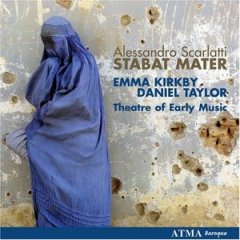Alessandro Scarlatti - Stabat Mater (Kirkby) [2006]
Alessandro Scarlatti - Stabat Mater (Kirkby) [2006]

1. Stabat Mater: Stabat Mater
2. Stabat Mater: Cuius animam gementem
3. Stabat Mater: O quam tristis et afflicta
4. Stabat Mater: Quae moerebat
5. Stabat Mater: Quis est homo
6. Stabat Mater: quis non posset contristari
7. Stabat Mater: Pro peccatis...
8. Stabat Mater: Vidit suum...
9. Stabat Mater: Pia Mater
10. Stabat Mater: Sancta Mater
11. Stabat Mater: Fac ut ardeat
12. Stabat Mater: Tui nati vulnerati
13. Stabat Mater: Luxta crucem...
14. Stabat Mater: Virgo virginum
15. Stabat Mater: Fac ut portem
16. Stabat Mater: Inflammatus et...
17. Stabat Mater: Fac me cruce
18. Stabat Mater: Quando corpus morietur
19. Concerto XXI: Andante
20. Concerto XXI: Allegro
21. Concerto XXI: Veloce
22. Concerto XXI: Lento
23. Concerto XXI: Allegro
Emma Kirkby : Soprano
Daniel Taylor : Alto
Theatre of Early Music
This quiet, circumspect, yet oddly moving recording of Alessandro Scarlatti's Stabat Mater is as far as can be imagined from the intense fireworks of another contemporary recording of the work, that led by conductor Rinaldo Alessandrini on the Naïve label. Soprano Emma Kirkby, countertenor Daniel Taylor, and the Montreal-based Theatre of Early Music (a period-instrument group founded by Taylor) tread catlike through the work, which was written some years before Pergolesi's more famous Stabat Mater setting but was commissioned by the same Italian religious order. The Scarlatti work, more than Pergolesi's, is full of quasi-operatic devices -- pregnant pauses, dissonant "sighs," and, in the final "Amen," some heady vocal acrobatics. In this performance everything is kept to a very quiet level, which may seem inappropriate to Scarlatti's basically theatrical language. Kirkby and Taylor are highly sensitive interpreters, however, and they work together (in the work's four luscious duets) and separately to bring out dissonances and unusual phrase shapes that get lost in a bigger interpretation. Kirkby does not have the absolute clarity of voice that she once did, but she has not lost any of her ability to bring quiet tension to a melodic line.
This chamber-sized Scarlatti Stabat Mater might have worked very well in a pairing with the more intimate Pergolesi work, but instead we get the Concerto XXI for flute, strings, and continuo, a little-known work. The intentions of the album are nowhere more clearly revealed than in the decision to replace the transverse flute with Francis Colpron's recorder -- usually it's done the other way around, but the quiet, conversational tone of the recorder and its ability to slide around the center of a consonance as needed fit what this ensemble is trying to do. One might wish for a new recording of the Stabat Mater by Cecilia Bartoli, a Scarlatti interpreter who can combine detail and athleticism, but for now this very expressive performance is worth checking out. ---James Manheim, Rovi
download: uploaded yandex 4shared mediafire solidfiles mega zalivalka filecloudio anonfiles oboom
Last Updated (Wednesday, 23 April 2014 21:24)








